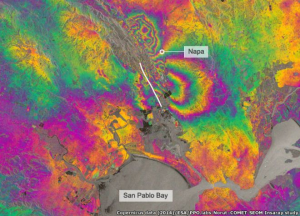COMET scientists have been closely involved with international efforts to analyse satellite data from the recent Nepal earthquake.

You can read more about the Sentinel-1A interferogram on the ESA website.
Links to some of the broader media coverage of our work can be found below.
BBC World Service Science Hour 02.05.15
Listen to Tim Wright describing images of the Nepal earthquake from Sentinel-1A satellite
BBC website 01.05.15
James Jackson, Philip England and Richard Walters are quoted in this article explaining why the Nepal earthquake was so deadly
BBC website 29.04.15
Tim Wright describes the Sentinel-1A interferogram of the area affected by the Nepal earthquake
James Jackson explains the risks associated with the Nepal earthquake

![Figure 4. Data, spherical source elastic half space model and residuals for recent deformation at Calbuco [Bagnardi].](http://tempcomet.leeds.ac.uk/wp-content/uploads/2015/04/Figure-4.-Spherical-source-Calbuco-300x137.png)
